Little Surname Ancestry ResultsOur indexes 1000-1999 include entries for the spelling 'little'. In the period you have requested, we have the following 1456 records (displaying 1191 to 1200): Single Surname Subscription | | | Buying all 1,456 results of this search individually would cost £8,368.00. But you can have free access to all 1,456 records for a year, to view, to save and print, for £100. Save £8,268.00. More... |
These sample scans are from the original record. You will get scans of the full pages or articles where the surname you searched for has been found. Your web browser may prevent the sample windows from opening; in this case please change your browser settings to allow pop-up windows from this site.  Outstanding soldiers of the East Lancashire Regiment
(1881-1901) Outstanding soldiers of the East Lancashire Regiment
(1881-1901)
Each year the best soldiers of the regiment were chosen for long service and good conduct medals. This register gives rank, name, regimental number, and date of recommendation. (The sample scan is from the East Surrey regiment). The register is essentially a register of recommendations, annotated with details of the issue of the medals. Where no gratuity accompanied the medal, the entry is marked 'W. G.' (without gratuity); where, for one reason or another, the medal was not issued, the entry is marked 'N. S.' (not sanctioned) and struck through. The regiment was based on the 30th Regimental District - Burnley. The 1st battalion embarked for Bengal in 1880, and in 1885 was stationed at Meean Meer; by 1895 it was at Lucknow, and took part in the Chitral Relief Force of that year. This added "Chitral" to the regimental honours. The battalion returned to England in 1900, but was almost immediately sent to South Africa, earning the distinction of "South Africa, 1900-02". The 2nd battalion returned from Ceylon and India in 1881 (having served in Afghanistan in 1878 to 1880, adding "Ahmad Khel" and "Afghanistan, 1878-80" to the colours), and in 1885 was stationed at Dover. In that year the battalion was moved to Ireland, from which it embarked for Gibraltar 21 January 1893. Returning to England briefly, the troops were sent off to India in 1897, and in 1906 were at Poona.LITTLE. Cost: £8.00.  | Sample scan, click to enlarge
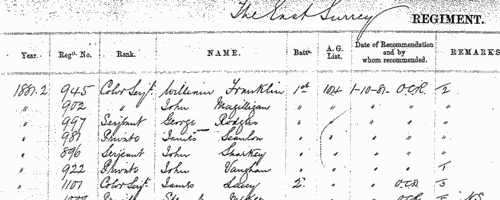
|  Outstanding soldiers of the King's Own (Scottish) Borderers
(1881-1901) Outstanding soldiers of the King's Own (Scottish) Borderers
(1881-1901)
Each year the best soldiers of the regiment were chosen for long service and good conduct medals. This register gives rank, name, regimental number, and date of recommendation. (The sample scan is from the East Surrey regiment). The register is essentially a register of recommendations, annotated with details of the issue of the medals. Where no gratuity accompanied the medal, the entry is marked 'W. G.' (without gratuity); where, for one reason or another, the medal was not issued, the entry is marked 'N. S.' (not sanctioned) and struck through. The regiment was based on the 25th Regimental District - Berwick-on-Tweed. The 1st battalion embarked for India 13 October 1875, and was stationed at Meerut by 1885. It returned from India 6 February 1891, and in 1895 was at York. The 2nd battalion returned from Aden to England 27 March 1876: in 1879 it was moved to Ireland and by 1885 was stationed at Dublin. After a brief stay on Gibraltar in 1886, the battalion returned to England. 19 July 1888 the battalion embarked for Egypt, and from there was sent into the Soudan, fighting at Gemaizah; it was moved back into Egypt in 1889, and in 1890 set sail for India, where in took part in the Chitral Relief Force and the North West Frontier campaign, adding "Chitral" and "Tirah" to the colours. In 1895 the troops were at Rawul Pindee. The regiment took part in the South African war, gaining the distinctions "South Africa, 1900-1902" and "Paardeberg".LITTLE. Cost: £8.00.  | Sample scan, click to enlarge
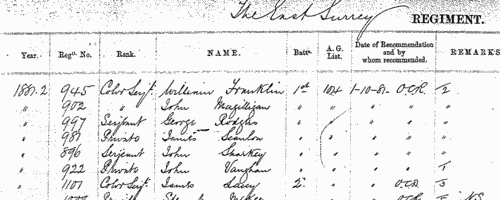
|  Outstanding soldiers of the Prince of Wales' (North Staffordshire Regiment)
(1881-1901) Outstanding soldiers of the Prince of Wales' (North Staffordshire Regiment)
(1881-1901)
Each year the best soldiers of the regiment were chosen for long service and good conduct medals. This register gives rank, name, regimental number, and date of recommendation. (The sample scan is from the East Surrey regiment). The register is essentially a register of recommendations, annotated with details of the issue of the medals. Where no gratuity accompanied the medal, the entry is marked 'W. G.' (without gratuity); where, for one reason or another, the medal was not issued, the entry is marked 'N. S.' (not sanctioned) and struck through. The regiment was based on the 64th Regimental District - Lichfield. The 1st battalion was transferred from the Channel Islands to Ireland in 1879; and from Ireland to England in 1883. In 1884 it embarked for the West Indies; in 1886 was sent from there to South Africa; in 1891 from South Africa to Mauritius; and in 1892 from Mauritius to Malta. In 1895 the battalion was moved to Egypt, taking part in the Dongola Expeditionary Force of 1896; and in 1897 to India. The 2nd battalion was serving in India in 1881, based at Quetta by 1885, and returned to England via Aden 30 March 1888. Having been moved to Ireland in 1893, it was sent to South Africa in 1900, and added "South Africa, 1900-1902" to the regimental honours.LITTLE. Cost: £8.00.  | Sample scan, click to enlarge
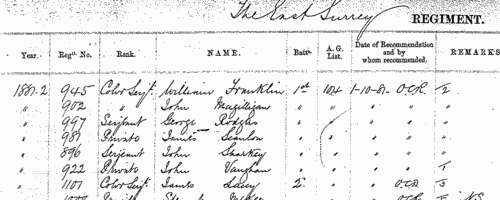
|  Outstanding soldiers of the Royal Engineers
(1881-1901) Outstanding soldiers of the Royal Engineers
(1881-1901)
Each year the best soldiers were chosen for long service and good conduct medals. This register gives rank, name, regimental number, and date of recommendation. (The sample scan is from the East Surrey regiment). The register is essentially a register of recommendations, annotated with details of the issue of the medals. Where no gratuity accompanied the medal, the entry is marked 'W. G.' (without gratuity); where, for one reason or another, the medal was not issued, the entry is marked 'N. S.' (not sanctioned) and struck through. LITTLE. Cost: £8.00.  | Sample scan, click to enlarge
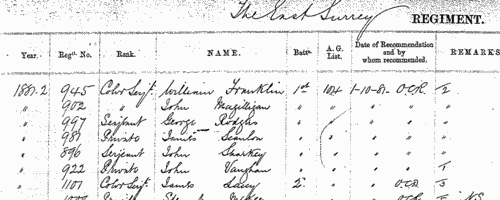
|  Outstanding soldiers of the Royal Fusiliers (City of London Regiment)
(1881-1901) Outstanding soldiers of the Royal Fusiliers (City of London Regiment)
(1881-1901)
Each year the best soldiers of the regiment were chosen for long service and good conduct medals. This register gives rank, name, regimental number, and date of recommendation. (The sample scan is from the East Surrey regiment). The register is essentially a register of recommendations, annotated with details of the issue of the medals. Where no gratuity accompanied the medal, the entry is marked 'W. G.' (without gratuity); where, for one reason or another, the medal was not issued, the entry is marked 'N. S.' (not sanctioned) and struck through. The regiment was based on the 7th Regimental District - Hounslow. The 1st battalion embarked for Gibraltar in 1885, and went on to India: it was based at Kurrachee by 1895. The 2nd battalion embarked for India 1 October 1873, and in 1885 was at Cannanore in Madras; it returned from India to England 29 March 1889, was moved to Ireland from Guernsey in 1895, and sent on to South Africa in 1899, where it added "South Africa, 1899-1902" and "Relief of Ladysmith" to the regimental honours.LITTLE. Cost: £8.00.  | Sample scan, click to enlarge
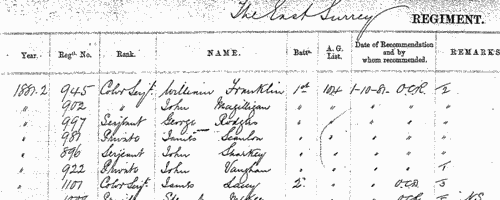
| Boys entering Epsom College
(1901)
The Royal Medical Benevolent College at Epsom in Surrey was founded in 1853 for the orphans of the medical profession, and evolved to become a public school still largely catering for sons of doctors and surgeons. In 1955 this register of pupils, from 1855 to 1954, edited by T. R. Thomson, was published. The sample scan is from 1880. The entries are arranged alphabetically by surname under year of entrance to the school; surname first (in bold), christian names, and then (in most cases), the father's name, occupation and address: then the boy's year of birth (b.), year of leaving (l.), occupation, and, where known, year of death (d.). From 1880 onwards the house to which the boy belonged is also indicated: the boarding houses were Carr (C.), Forest (F.), Granville (G.), Holman (H.), Propert (P.) and Wilson (W.); and Crawfurd (Cr.), Hart Smith (H. S.) and Rosebery (R.) are the houses for day scholars. From 1895 to 1927 there was a junior school, called Lower School (L. S.), taking in boys from the age of 8, many passing seamlessly into the main school at age 12 to 14. This is the index to the year 1901, when the Reverend Thomas Northmore Hart-Smith was headmaster. LITTLE. Cost: £4.00.  | Sample scan, click to enlarge

| Boys entering Marlborough College
(1901)
The public school at Marlborough in Wiltshire was founded in 1843. In 1952 this, 9th, edition of the college register was published, being a revision by L. Warwick James of the 8th edition (of 1936): but for the years before 1936 it does not merely repeat the 8th edition, because Warwick James was able to correct the 19th-century entries with information from newly-discovered letters and books from 1843 to 1853, and the school lists from 1844 onwards. The roll is arranged by year, and within each year by term of entrance, and then alphabetically by surname within each term. Each boy is assigned a number within the year: then his name is given, surname first, and, in brackets, his house. The houses within the college were called B1, B2, B3, C1, C2 and C3, and the Lower School (L Sch); the out college houses were Preshute, Priory, Cotton, Hermitage, Littlefield, Barton Hill, Summerfield and Upcot. Then there is given the boy's father's name (surname and initials) and address (at entrance), the boy's date of birth (b) and month of leaving (l). Where the boy represented the school at Rugby football (XV) or cricket (XI), in the rifle corps (VIII, or RC XI), that is indicated. There is a brief summary of achievements in later life, and, where known, and date of death or (in italics) address as in 1952. LITTLE. Cost: £4.00.  | Sample scan, click to enlarge
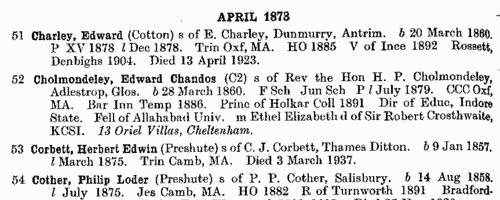
| Unclaimed Naval Prize Money
(1855-1902)
Various prize moneys were awarded to officers and men who served on board her Majesty's ships. For one reason or another a substantial number of these prizes, from as little as a shilling or two to as much as many pounds, remained undistributed by 1902, when this comprehensive list of the unclaimed moneys was printed: it lists unclaimed shares of prize money, slave and pirate bounties, salvage awards, parliamentary grants, gratuities and other moneys distributed by the Admiralty 1855 to 1902, but which omits moneys for service on the China Station during the war of 1856 to 1880, and special gratuities for service in Egypt (1882), Soudan (1884) and Soudan and Nile Expedition (1884-1885), for which there are separate indexes. In each case the sailor's name is given first (surname, then christian name or initials); rank or rating; ship in which serving at time of capture or award; and the amount due.LITTLE. Cost: £6.00.  | Sample scan, click to enlarge

|  London Metropolitan Police
(1892-1902) London Metropolitan Police
(1892-1902)
The London Metropolitan Police Register of Joiners (MEPO 4/336) lists policemen joining the force 1 January 1892 to 23 June 1902 (warrant numbers 77319 to 88811). The register is alphabetical, in so far as the recruits are listed chronologically grouped under first letter of surname. It gives Date of Appointment, Name, Number of Warrant, Cause of Removal from Force (resigned, dismissed, promoted or died), and Date of Removal. A final column of 'Remarks' is largely blank, but occasionally gives an alias or a cross-reference to another warrant number.LITTLE. Cost: £8.00.  | Sample scan, click to enlarge

|  British artillerymen fighting in South Africa
(1899-1902) British artillerymen fighting in South Africa
(1899-1902)
The Queen Victoria's South Africa Medal was awarded (after her death, in the event) to all who had served honourably in the various campaigns in the Boer War. Returns were made from each unit, and consolidated into nominal roll, of which this is the one for the Royal Artillery. Confusingly, the ledgers used had originally been printed for a register of men transferred (or re-transferred after mobilization) to 1st Class Army Reserve. All the original column headings were therefore struck through, and the roll was prepared with this information: Date of Issue; Regimental Number; Rank; Name; Unit; Medal (a 1 indicating that a medal was awarded); [number of] Clasps; the reference to the source in the original returns, usually starting with AG for papers in the hands of the Adjutant-General, and 68/Art/ for the Royal Artillery records. The final column, normally left blank, was occasionally used for explanatory remarks.LITTLE. Cost: £8.00.  | Sample scan, click to enlarge

|
Research your ancestry, family history, genealogy and one-name study by direct access to original records and archives indexed by surname.
|













